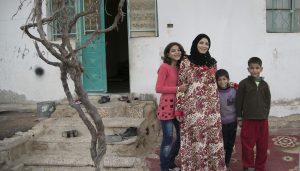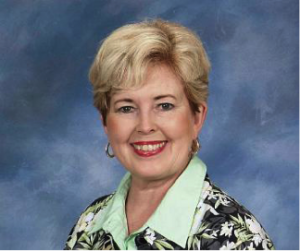
by Steve | Jan 13, 2020 | January - February 2020, Magazine, Magazine Articles

Ghoussoon and her children are featured in the film Salam Neighbor. They are refugees from Syria. Photo: Mohab Khattab.
By Max A. Wilkins –
God is a missionary God. From the moment of creation as told in Genesis, God makes his missionary nature known. With Jesus’ earthly mission, God burst forth into creation showing his missional heart. Jesus not only modeled a missional life, he also established the Church and called her to join him in his mission. Thus, mission is the reason the church exists. And from its inception, the church has always been on mission. As The United Methodist Church wrestles with what it looks like to be the Church in 2020 and beyond, one thing is certain: we will always be called to be missional.
While the call to join Jesus in his mission is universal, there are multitudes of ways for the church to be on mission. And many of the models seen in the early church are still fruitful models today. Let’s look at five missionary models of the early church.
The Prayer Meeting Response. In his last instructions to his disciples before ascending to heaven, Jesus told them to go down to Jerusalem, get in a prayer meeting, get filled with the Holy Spirit, and, under the power of the Holy Spirit, to become missionary witnesses. The church was born as a result of that prayer meeting. And down through the ages many missionary movements have been launched in a similar fashion.
In the mid-1800s just such a prayer meeting took place among a group of Methodists. The result was a mission movement to West Africa. Though many of the members of that prayer meeting died young on the mission field, the remaining members continued to go. As a result, the Methodist Church of Ghana exists today, a church that saw over 55,000 new believers come to faith last year alone! There is power in the prayer meeting when the Holy Spirit shows up!
The Local Sending Church. Through the efforts of Paul, Barnabas, and others, God grew a great church in Antioch of Syria. It rapidly became a missional church. In 44 AD, the church at worship felt the prompting of the Holy Spirit to send forth missionaries into Asia Minor (see Acts 13). They laid hands on Paul and Barnabas and began a long, fruitful, multi-year engagement with missionaries sent out from their church. The missionaries from Antioch maintained a relationship with the church of accountability, support, encouragement, and resourcing. Many churches in North America today are becoming sending churches, or partnering with mission sending agencies to jointly send cross-cultural witnesses who maintain the same kinds of relationship with the church as witnessed in Acts 13.
The Immigrant Relations Strategy. Located along some major trade routes, ancient Palestine was a land of many immigrants and foreigners. The early church often took advantage of this home-grown opportunity for cross-cultural engagement with amazing results. In Acts 8, we read the story of Philip, an early church missionary. Sent by God from Jerusalem toward Gaza, he wasn’t at all sure where he was going; only what he was doing! Upon seeing a high official of the Ethiopian court, he knew his mission field. The ensuing engagement between Philip and the inquisitive foreigner resulted in new life for the Ethiopian, who immediately returned to Ethiopia and took the gospel with him! We see this pattern repeated throughout the New Testament. Today, with a global immigrant population exceeding 250 million people, there has never been a better or more fruitful season for employing this missional strategy.
The Mentor/Mentee Model. The Apostle Paul made several fruitless trips to a backwater town called Lystra. On his third trip, however, he encountered Timothy, a young man of mixed heritage about whom the believers spoke highly. Discerning both the gifts the Holy Spirit had implanted in Timothy and the missionary call of his life, Paul takes him on the road. In the next few years Paul not only mentored Timothy and modeled mission work for him, he also set Timothy on a course for an adult life as a missionary. Paul would subsequently repeat this model over and over again.
Today, missionary sending agencies are finding their greatest mobilizing success when current missionaries are putting forth the call to young people and then mentoring and modeling mission for them. And local churches that make a place for missionaries to put forth the call to their congregation are a big part of the success of this model.
The Persecution/Dislocation Model. Jesus called his disciples to be his witnesses not only in Jerusalem but to the ends of the earth. Sadly, in the earliest days of the church, the disciples found it more comfortable and convenient to remain in Jerusalem. Then persecution broke out against the church. Suddenly, in response to the persecution, the believers were displaced and scattered all over the Roman world. The result was missionary work to the ends of the earth!
No one likes persecution. We pray for the persecuted church. But the reality is that God can also redeem persecution. Indeed, though many of the current global displacement challenges have resulted in the uprooting of centuries old Christian communities around the globe, it has also afforded these refugees incredible platforms for engaging both their host countries, and their fellow refugees, in mission. It is also incredibly fruitful when churches in North America partner with refugee believers in their midst, and resource, encourage, and empower them for mission.
According to Acts, in the early church the Lord was adding to their numbers daily those who were embracing the gospel of Jesus Christ. The mission continues today. And, perhaps by embracing some of the missional strategies we see modeled in the early church, we will also see the kingdom fruit experienced by the early church. May it be so.
Max Wilkins serves as President and CEO of TMS Global. He previously pastored churches in Florida and Hawaii for 30 years.

by Steve | Jan 13, 2020 | January - February 2020, Magazine, Magazine Articles
 By B.J. Funk –
By B.J. Funk –
Wouldn’t it be nice if kindness made a comeback? Wouldn’t it be nice if we weren’t afraid to send our children to school, to go shopping at the mall, or to go without fear into a movie theater? Wouldn’t it be nice if church were a safe place to be, if sidewalks weren’t dangerous, and if Andy and Barney could walk the streets of our town without a gun?
Wouldn’t it be nice to go back many years ago and have Fred Rogers on television again, speaking kindness, love and acceptance to our children through his show, Mr. Rogers’ Neighborhood? The show ran on PBS for over thirty-five years. He taped more than 900 programs, winning four Emmys for his slow-moving, slow-talking visits with the children in his television audience. His central message to them was “You are loved just the way you are.”
He sat before the camera and gave children what they needed every day, large doses of kindness with a huge amount of love. Without knowing his audience individually, he approached the children with a voice that said, “Come on in to my neighborhood. You are always welcomed here.” And the children knew they were.
Mr. Rogers was an ordained Presbyterian minister who kept his status with the church current by appearing regularly before church elders. But his calling was to bless children by teaching his central message of God’s love for all creation. He once said that his ministry was the “broadcasting of grace” throughout the land, and his vocation was to minister to children through the medium of television. Before taping each of those 900 programs, Rogers offered this simple prayer: “Let some word that is heard be thine.”
He had a name for the space between the viewer and the television set. He called that space, “Holy Ground.” That’s a beautiful picture for us in 2020. Unfortunately, that space is for some of our children not Holy Ground but instead a breeding ground for the unfortunate introduction of too much cursing, unnecessary fighting, and relentless screaming coming through the air waves. Some of our children, left alone without parental oversight, sit in the area Mr. Rogers called Holy and receive a far too early look into the raw and deviant side of humanity. Forgive us, Lord.
Mr. Rogers saw the potential for holiness in every experience through the power of the Holy Spirit. He brought the medium of kindness and acceptance as the doorway into faith and holy living. He invited the children to be his neighbor, to sit with him during his show as they joined hands in neighborly love.
Some have named him a televangelist to toddlers. He would likely have been uncomfortable with that thought, but that is exactly what he was doing. If our gospel is the gospel of grace, then Fred Rogers was seeking to offer the Good News of grace daily through his show.
Faith was so much a part of who he was, as it should be for each of us. His faith moved through his being in simple, yet powerful ways. Having faith was part of his makeup. It affected him in every moment.
If you haven’t thought about Fred Rogers lately, now would be a good time to renew your friendship with this soft-spoken man through the recent release of a movie about his life. Tom Hanks stars as Mr. Rogers in a delightful walk back to the years of his show, 1962-2001. Or you can read Shea Tuttle’s book, Exactly as You Are: The Life and Faith of Mister Rogers.
Practicing kindness has a profound effect on our own mental and physiological health. Being kind helps us to become happier and more compassionate towards others. Being kind can help boost our own immune system, slow down aging, elevate our self-esteem and improve blood pressure.
“Kindness makes a person attractive. If you could win the world, melt it, do not hammer it,” wrote Alexander MacClaren, an English minister born in the nineteenth century.
So, let’s see if we can do our part for kindness to make a comeback. It’s worth a try. And, by the way, will you be my neighbor?

by Steve | Jan 13, 2020 | January - February 2020, Magazine, Magazine Articles

Baptism at Christ’s Foundry Fellowship in Dallas. Photo courtesy of Christ’s Foundry Fellowship.
By Heather Hahn –
The U.S.’s majority status in The United Methodist Church is coming to an end – and may be there already. That’s according to projections from the denomination’s General Council on Finance and Administration – based on the continuing decline in U.S. membership as much as growth in Africa.
According to the agency’s forecast, total membership in the central conferences – church regions in Africa, the Philippines and Europe – will exceed that of the U.S. jurisdictions in 2020.
“Based on trends that have occurred over the last several years, we are annually averaging a decline of 2.0 percent overall for the jurisdictional membership,” Kevin Dunn, the agency’s director of data services, told the GCFA board at its November meeting. “We may fall below 6 million (U.S.) members by 2025.”
It’s a significant development for a church whose governance and history have both helped shape and been shaped by the United States, where the denomination got its start in 1784.
Dunn said the U.S. decline has largely resulted from members’ deaths – people leaving The United Methodist Church for the church triumphant.
However, starting in 2014, he said, the overall drop has exceeded the number of funerals. U.S. worship attendance also has been shrinking as a percentage of overall membership for the past decade.
Dunn noted that United Methodist numbers are in keeping with overall U.S. religious trends. In October, Pew Research Center reported losses across Christian groups while showing the religiously unaffiliated rising to more than a quarter of U.S. adults.
Even with shrinking U.S. rolls, The United Methodist Church is still the country’s third largest denomination – behind the Catholic Church and Southern Baptist Convention.
The most recent data GCFA actually has on hand is the U.S. membership and attendance figures for 2018. Unequal infrastructure and technology typically mean that membership reports are usually out of sync between the U.S. and the rest of the globe.
On its website, umdata.org, the agency reports the U.S. church had just under 6.7 million members at the end of 2018 — down from about 6.8 million in 2017. In the U.S., average weekly attendance was under 2.5 million in 2018, a decline of about 3.6 percent from the previous year.
The agency’s most recent data for the central conferences is from 2017, when the denomination counted more than 6.4 million members in Africa, Europe, and the Philippines. That’s up from about 5.7 million members in 2015.
However, the central conference total comes with an asterisk. On its data services website, GCFA notes that the 2017 numbers reflect the most recent submitted. Where conferences have not reported any new data, the agency carries over numbers from previous reporting.
The story of the church in the U.S. is not strictly one of decline. “We have some good news,” Dunn said. “Our Hispanic and multiracial growth has consistently been trending upwards 2 percent to 3 percent (a year) in each category.” Between 2009 and 2018, the number of U.S. members identifying as multiracial increased from 45,955 to 68,029. In the same period, the number of Hispanic United Methodists has grown from 68,088 to 80,968.

Family Fun Night at Christ’s Foundry Fellowship in Dallas. Photo courtesy of Christ’s Foundry Fellowship.
The predominantly Hispanic Christ’s Foundry Fellowship in Dallas is an example of that growth. The North Texas Conference decided more than 10 years ago to plant a congregation in a growing Latino neighborhood. The congregation that began as a small group worshipping in various locations has grown to 166 members and 228 in average weekly attendance.
The Rev. Lucia “Lucy” French, the congregation’s associate pastor, attributed the congregation’s growth to several programs the church instituted early on. These include small groups, a worker association to help people find employment and Family Wednesday — Miercoles de Familias — a time for children’s choir, youth group, parenting classes and marriage instruction. French, who came to Dallas from Quito, Ecuador in 2006, found her calling as a pastor by leading the Wednesday night programs.
“Everything that has happened in the growth and development at Christ’s Foundry has been the result of many collaborators, each bringing their unique strengths, resources, talents, and dedication to the effort,” she said, with interpretation from her husband, John.
Christ’s Foundry, which now has a building to call its own, is also now taking a lead role in the North Texas Conference’s response to recent tornadoes that wreaked havoc on the city.
“The congregation of Christ’s Foundry has been and continues to be blessed by the community, and has shown its ability and willingness to be a blessing to others in the community by living their faith,” the pastor said. “While head counts and budgets have their place, this is the best measure of success.”
What about General Conference?
Membership plays a large role in determining how many delegates each annual conference can send to General Conference, the denomination’s top lawmaking body. The Book of Discipline outlines a statistical formula for delegation size based on the number of clergy and professing lay members of each annual conference. Each annual conference must have a minimum of one lay and one clergy delegate. However, the latest figures from the General Council on Finance and Administration will not be reflected in the composition of next year’s General Conference.
The Rev. Gary Graves, General Conference secretary, determined the size of each annual conference’s delegation in 2017, based on data in the most recent annual conference journals submitted to GCFA.
Of the 862 delegates in 2020, 55.9 percent will be from the U.S., 32 percent from Africa, 6 percent from the Philippines, 4.6 percent from Europe and the remainder from concordat churches that have close ties to The United Methodist Church. Compared to the 2019 special session, the U.S. will have fewer delegates overall, while African delegations gain 18 and the Philippines two.
Heather Hahn is a multimedia news reporter for United Methodist News. Distributed by United Methodist News.



 By B.J. Funk –
By B.J. Funk –
